Strong, well-developed deltoids are key to upper-body power and aesthetics. Whether you’re looking to increase strength, improve stability, or enhance muscle definition, incorporating effective shoulder exercises is essential.
This guide highlights six of the best deltoid exercises to help you build mass and strength, ensuring balanced development across all three deltoid heads—anterior, lateral, and posterior.
With the right techniques and consistency, you’ll see noticeable improvements in both performance and appearance.
Big, strong shoulders are the goal of many bodybuilders. To achieve the “V” shape, you need to train smart to get better results.
To do this, you need to choose the right exercises and incorporate them correctly into your training.
Therefore, this article will cover the best exercises for the delts, as well as a sample training routine and more.
Why shoulder training matters
The deltoids are muscles that are important beyond hypertrophy.
It’s important to work the deltoids because of their role in stabilizing the shoulder joint.
The shoulder joint is characterized by a high degree of mobility, but in order to avoid injuries in this region, it is necessary to improve its stability.
It is also important to train the deltoids to improve posture and performance in different sports activities.
Shoulder anatomy and key movements
The shoulder is a complex joint that performs a variety of movements, including:
- shoulder flexion and extension,
- internal and external rotation,
- shoulder abduction and adduction.
The shoulder joint is made up of tendons, bones, and muscles.
The muscles that make up the shoulder joint are: Deltoids, Biceps Brachii, Triceps Brachii, Pectoralis Major, Latissimus Dorsi.
The different bones in the shoulder joint are:
- Scapula
- Clavicle
- Acromion
- Glenohumeral Capsule.
The shoulder consists of four joints: the sternoclavicular joint, the scapulothoracic joint, the glenohumeral joint, and the acromioclavicular joint.
The best 6 delts exercises
To get the best results, you need to choose the best exercises and achieve large deltoids.
So here are examples of 6 important exercises for building big delts:
1° Barbell shoulder press
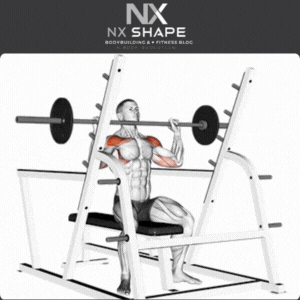
This exercise is the primary exercise for developing strength in the deltoids and also for building muscle, making it an important part of the training routine.
Muscles worked:The main muscles worked during the barbell shoulder press are the anterior deltoid and the middle deltoid, but it also works the trapezius and triceps muscles.
How to: Begin by sitting on the bench with the bar resting on the rack.
Position your hands in a pronated grip, slightly more than shoulder width apart.
Begin the exercise by removing the bar from the rack and lifting it above your head until your elbows are extended.
Finish by flexing your elbows until the bar is near chest height and repeat the movement until you reach the set number of repetitions.
2° Dumbbell Front raise
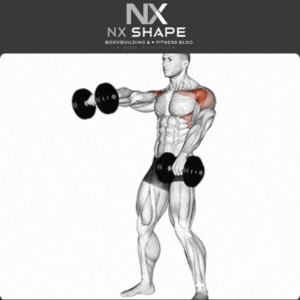
The front raise with dumbbells allows you to build deltoids with the ball-like appearance seen from the side.
Muscles worked:The main muscles worked in this exercise are the anterior deltoid and the lateral deltoid, as well as muscles such as the biceps and trapezius.
How to:To begin this exercise, you will need to hold a dumbbell in each hand, both positioned next to your body.
Begin the movement by raising both arms to shoulder height, then return them to the starting position.
3° Dumbbell Lateral raise
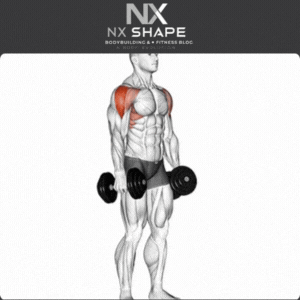
To work the lateral deltoid region and achieve the appearance of broad, strong shoulders, the lateral raise is an excellent exercise to achieve this goal.
Muscles worked:The main muscles worked in this exercise are the lateral deltoid, with some involvement from the frontal deltoid, and the trapezius muscle.
How to: Begin this exercise with a dumbbell in each hand and your arms at your sides.
Raise your arms out to the sides until they reach shoulder height, then lower your arms until they are at your sides again.
4° Upright row
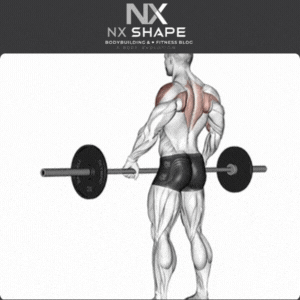
Although it is considered by many to be a dangerous exercise, the upright row can produce great results and help you develop broader shoulders.
Muscles worked:The main muscles worked are the lateral deltoid, upper back and traps.
How to: Begin the exercise by holding a barbell in front of you.
Hands should be slightly off the shoulder line.
Raise the barbell by bringing your elbows toward your shoulders until your elbows reach shoulder height, then extend your arms until you return to starting position.
5° Rear delt fly
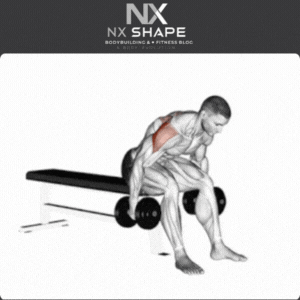
Exercises that focus on the posterior deltoid are often neglected.
However, in order to get bigger deltoids, you must include exercises for this area.
Muscles worked: The Rear Deltoid Fly works primarily the posterior deltoid region, but also the rhomboids, trapezius, and lats.
How to: To begin, sit on a bench with a dumbbell in each hand and lean forward.
The exercise begins by opening your arms until your elbows are in line with your shoulders, then lower your arms and repeat the movement according to the training plan.
6° Cable face pull
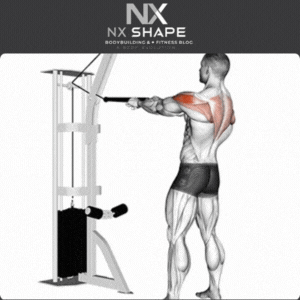
The Cable Face Pull is a great way to work the posterior shoulder muscles and is also important for improving posture and reducing shoulder pain.
Muscles worked: The main muscle worked is the posterior deltoid, but the rhomboids, trapezius and rotator cuff are also worked.
How to: To begin the exercise, position the pulley at the top, above your head.
Then hold the rope with your hands and pull your elbows back until you’ve contracted your back muscles as much as possible.
It’s important to remember to keep your elbows at shoulder height in order to work the posterior deltoid muscles as much as possible.
Shoulder workout routine for size
To get the best results, you need a workout routine that is capable of stimulating the muscles intensely to produce greater muscle gains.
Therefore, the following is a shoulder training routine.
It’s worth remembering that sets, repetitions and intervals should be adjusted to suit each person’s level and other needs.
| Exercise | Sets | Reps | Rest(seconds) |
| Barbell shoulder press | 5 | 6-8 | 120 |
| Dumbell frontal raises | 4 | 10-12 | 90 |
| Dumbell lateral raises | 4 | 10-12 | 90 |
| Upright row | 4 | 8-10 | 90 |
| Rear del fly | 4 | 12-15 | 60 |
| Cable face pull | 3 | 12-15 | 60 |
Tips to avoid shoulder injuries
To have big, strong deltoids, you need to train hard, but as we said at the beginning, this joint is very susceptible to injury if you don’t take the necessary precautions.
Here are some tips to help you avoid training injuries ande get the best results from youryour workout.
- Warm up. Begin your workout with 2 to 3 sets of light weight to warm up and prepare the joint for the workout.
Never start with heavier loads as this increases the risk of injury, so prepare before training and increase the load gradually.
- Prioritize technique. Before increasing the weight of the exercises, try to perfect the technique of each exercise.
Increasing the weight too much and failing to perform the exercise correctly can overload the joint and increase the risk of injury.
- Strengthen the rotator cuff. The rotator cuff is responsible for stabilizing and moving the shoulder.
To reduce the risk of injury, it is important to strengthen the muscles that make up the rotator cuff.
- Don’t neglect any pain you feel. At the slightest sign of discomfort or pain in the joint, you should seek professional help.
Often small problems can become bigger if you don’t take the necessary care.
Achieving large, broad shoulders that stand out in the physique is a goal that many bodybuilders strive for.
Therefore, you need to be aware of how to incorporate each exercise and take precautions to avoid shoulder injuries.
Always remember that execution and technique are the most important aspects of training, so never neglect them.


